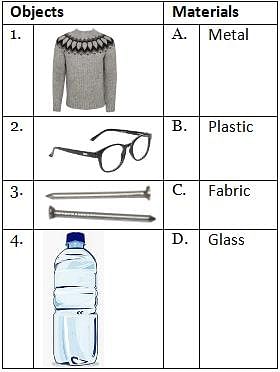Class 2 Exam > Class 2 Tests > Science Olympiad for Class 2 > Olympiad Test Level 2: Water and Rocks - 1 - Class 2 MCQ
Olympiad Test Level 2: Water and Rocks - 1 - Class 2 MCQ
Test Description
10 Questions MCQ Test Science Olympiad for Class 2 - Olympiad Test Level 2: Water and Rocks - 1
Olympiad Test Level 2: Water and Rocks - 1 for Class 2 2025 is part of Science Olympiad for Class 2 preparation. The Olympiad Test Level 2: Water and Rocks - 1 questions and answers have been
prepared according to the Class 2 exam syllabus.The Olympiad Test Level 2: Water and Rocks - 1 MCQs are made for Class 2 2025 Exam. Find important
definitions, questions, notes, meanings, examples, exercises, MCQs and online tests for Olympiad Test Level 2: Water and Rocks - 1 below.
Solutions of Olympiad Test Level 2: Water and Rocks - 1 questions in English are available as part of our Science Olympiad for Class 2 for Class 2 & Olympiad Test Level 2: Water and Rocks - 1 solutions in
Hindi for Science Olympiad for Class 2 course. Download more important topics, notes, lectures and mock
test series for Class 2 Exam by signing up for free. Attempt Olympiad Test Level 2: Water and Rocks - 1 | 10 questions in 20 minutes | Mock test for Class 2 preparation | Free important questions MCQ to study Science Olympiad for Class 2 for Class 2 Exam | Download free PDF with solutions
Olympiad Test Level 2: Water and Rocks - 1 - Question 1
The magnet will pick up the nail but not the penny because the nail:


Detailed Solution for Olympiad Test Level 2: Water and Rocks - 1 - Question 1
Olympiad Test Level 2: Water and Rocks - 1 - Question 2
What is the process of change of liquid into solid called ?
Detailed Solution for Olympiad Test Level 2: Water and Rocks - 1 - Question 2
| 1 Crore+ students have signed up on EduRev. Have you? Download the App |
Olympiad Test Level 2: Water and Rocks - 1 - Question 3
Calculate the total number of solid things.


Detailed Solution for Olympiad Test Level 2: Water and Rocks - 1 - Question 3
Olympiad Test Level 2: Water and Rocks - 1 - Question 4
What can change matter from one state to another state ?
Olympiad Test Level 2: Water and Rocks - 1 - Question 5
State true or false (T/F)
A. Air cannot be seen but can be touched
B. Water is in liquid state in form of ice.
C. The process of changing of a solid to a liquid is called melting.
Detailed Solution for Olympiad Test Level 2: Water and Rocks - 1 - Question 5
Olympiad Test Level 2: Water and Rocks - 1 - Question 6
Which of the following group has size but do not have fixed shape.
Detailed Solution for Olympiad Test Level 2: Water and Rocks - 1 - Question 6
Olympiad Test Level 2: Water and Rocks - 1 - Question 7
Read the given sentences and choose True or False (T/F)
A. Honey is a solid matter
B. Chalk melts in water.
C. Ice cream melts into a cream in refrigerator.
Detailed Solution for Olympiad Test Level 2: Water and Rocks - 1 - Question 7
Olympiad Test Level 2: Water and Rocks - 1 - Question 8
Match the following objects with the material they are made of :

Detailed Solution for Olympiad Test Level 2: Water and Rocks - 1 - Question 8
Olympiad Test Level 2: Water and Rocks - 1 - Question 9
Water can exist in _____ state of matter.
Detailed Solution for Olympiad Test Level 2: Water and Rocks - 1 - Question 9
Detailed Solution for Olympiad Test Level 2: Water and Rocks - 1 - Question 10
|
39 videos|40 docs|76 tests
|
Information about Olympiad Test Level 2: Water and Rocks - 1 Page
In this test you can find the Exam questions for Olympiad Test Level 2: Water and Rocks - 1 solved & explained in the simplest way possible.
Besides giving Questions and answers for Olympiad Test Level 2: Water and Rocks - 1, EduRev gives you an ample number of Online tests for practice
|
39 videos|40 docs|76 tests
|
Download as PDF

















